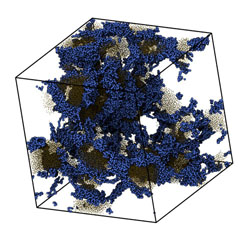Discerete Element Method
- Demonstration
A block of 16,000 spheres with random diameters which are let to interact in gravity feild using DEM pair force calculation. the simulation is two times faster than the realtime happening.
- Particle Tower
A block of 150,000 spheres with random diameters which are let to interact in gravity feild using DEM pair force calculation. GPIUTMD can simulate the system about 200 step per second. The interactions in the right tower is without friction and the in the left tower there is a coefficient of friction about 0.3 .
- Rigid Bodies
A ballmill is simulated using DEM pair forces and a special rigid body dynamics algorithm. the simulation contains 250 cubes of 122 particle and 500 spheres. There is a torque controler implemented in the simulation to keep the ballmill angular velocity constant.
LCD Self Assembly
- LCD Self Assembly (Hexagonal Crystal)
Self Assembly of a Liquid crystal, simulated using a T-Shape assembling unit. After 1 microsecond the system is completly formed into hexagonal colomnar phase.
- LCD Self Assembly 2 (Smectic Crystal)
Self Assembly of a Liquid crystal, simulated using Rod-Shape assembling unit. After 1 microsecond the system is completly formed into smectic phase.
Epon862/Detda composite
- Tension Test
A tension simulation on Epon862/Detda composite.
NPT Ensemble
- Demonstration
An Epon862/TETA cured polymer network simulated in atmospheric pressure, decreasing the temperature. The simulation is about 20ns long. it only takes 10 min for GPIUTMD to simulate the system.

